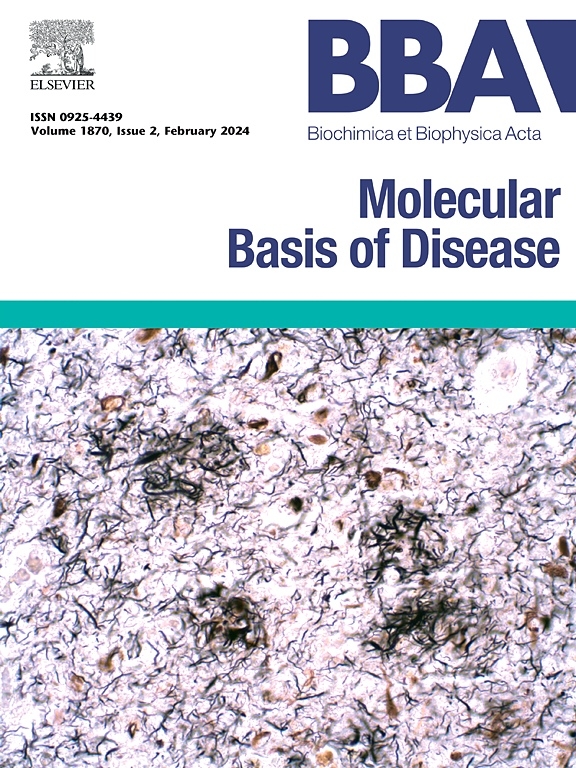2-Chloroethanol induces hepatic toxicity by disrupting endoplasmic reticulum homeostasis ameliorated by dimethyl sulfoxide
IF 4.2
2区 生物学
Q2 BIOCHEMISTRY & MOLECULAR BIOLOGY
Biochimica et biophysica acta. Molecular basis of disease
Pub Date : 2025-08-15
DOI:10.1016/j.bbadis.2025.168017
引用次数: 0
Abstract
2-Chloroethanol (2CE), a metabolite of ethylene oxide, vinyl chloride, and 1,2-dichloroethene, induces acute liver injury, but its mechanisms remain poorly defined. In this study, we demonstrate that 2CE disrupts endoplasmic reticulum (ER) homeostasis and activates unfolded protein response (UPR) signaling in both mouse liver and H4IIEC3 hepatoma cells. While in vivo eIF2α–CHOP signaling predominated, all three canonical UPR branches—IRE1α–XBP1s, PERK–eIF2α–CHOP, and ATF6—were activated in vitro. Notably, 2CE-induced XBP1s expression was transient, whereas pro-apoptotic UPR signaling persisted, suggesting an imbalance. Among several ER stress modulators tested, only dimethyl sulfoxide (DMSO) significantly improved cell viability and increased the 24-h LD₅₀ of 2CE in mice. Mechanistically, DMSO sustained XBP1s expression while reducing eIF2α phosphorylation, CHOP expression, and cleaved ATF6, indicating a rebalancing of UPR signaling toward a pro-survival state. Pharmacologic inhibition of IRE1α with 4μ8C abolished the protective effect of DMSO, suppressed XBP1s, and elevated cleaved caspase-3, confirming the critical role of the IRE1α–XBP1s axis in cytoprotection. These findings highlight UPR signaling dynamics as a central feature of 2CE-induced ER stress and identify IRE1α–XBP1s as a promising therapeutic target.
2-氯乙醇通过破坏经二甲亚砜改善的内质网稳态诱导肝毒性
2-氯乙醇(2CE)是环氧乙烷、氯乙烯和1,2-二氯乙烯的代谢物,可引起急性肝损伤,但其机制尚不明确。在这项研究中,我们证明2CE在小鼠肝脏和H4IIEC3肝癌细胞中破坏内质网(ER)稳态并激活未折叠蛋白反应(UPR)信号。虽然在体内eIF2α-CHOP信号占主导地位,但所有三个典型的UPR分支- ire1 α - xbp1s, PERK-eIF2α-CHOP和atf6在体外被激活。值得注意的是,2ce诱导的XBP1s表达是短暂的,而促凋亡UPR信号持续存在,提示不平衡。在测试的几种内质酰胺应激调节剂中,只有二甲基亚砜(DMSO)显着提高了细胞活力,并增加了小鼠体内2CE的24小时LD₅0。在机制上,DMSO维持XBP1s的表达,同时降低eIF2α磷酸化、CHOP表达和切割ATF6,表明UPR信号重新平衡到促生存状态。4μ8C对IRE1α的药理学抑制可消除DMSO的保护作用,抑制XBP1s,升高cleaved - caspase-3,证实IRE1α - XBP1s轴在细胞保护中的关键作用。这些发现强调了UPR信号动力学是2ce诱导内质网应激的核心特征,并确定IRE1α-XBP1s是一个有希望的治疗靶点。
本文章由计算机程序翻译,如有差异,请以英文原文为准。
求助全文
约1分钟内获得全文
求助全文
来源期刊
CiteScore
12.30
自引率
0.00%
发文量
218
审稿时长
32 days
期刊介绍:
BBA Molecular Basis of Disease addresses the biochemistry and molecular genetics of disease processes and models of human disease. This journal covers aspects of aging, cancer, metabolic-, neurological-, and immunological-based disease. Manuscripts focused on using animal models to elucidate biochemical and mechanistic insight in each of these conditions, are particularly encouraged. Manuscripts should emphasize the underlying mechanisms of disease pathways and provide novel contributions to the understanding and/or treatment of these disorders. Highly descriptive and method development submissions may be declined without full review. The submission of uninvited reviews to BBA - Molecular Basis of Disease is strongly discouraged, and any such uninvited review should be accompanied by a coverletter outlining the compelling reasons why the review should be considered.

 求助内容:
求助内容: 应助结果提醒方式:
应助结果提醒方式:


